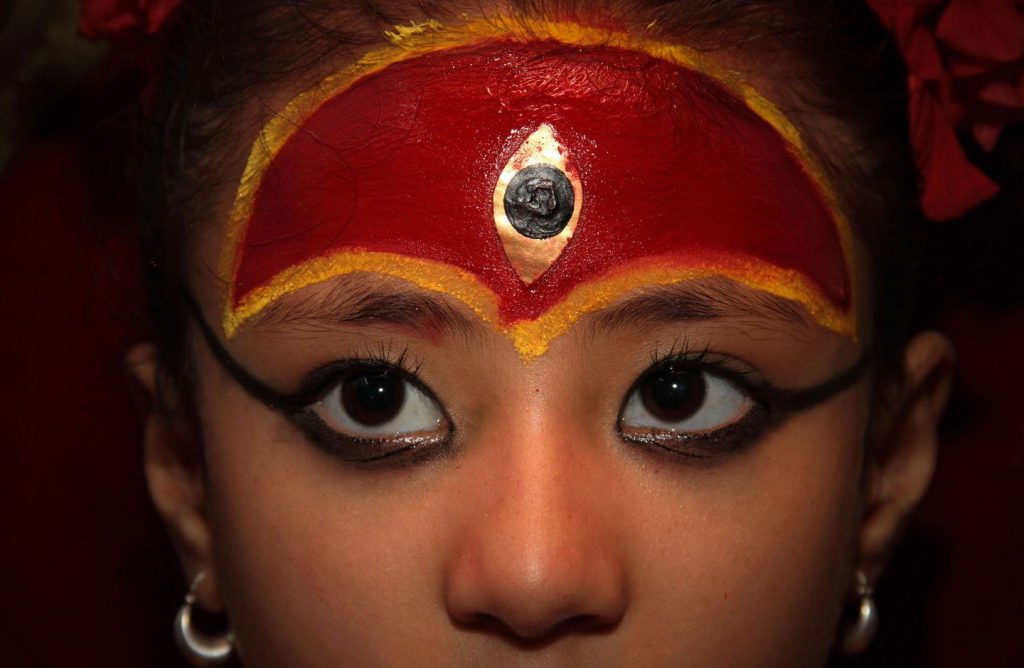Winner of the Fall 2017 StMU History Media Award for
Best Article in the Category of “Religion”
In most religious traditions, god and goddesses exist only in the spiritual realm, and are worshiped and revered in various forms, from statues and paintings to symbols and faith. But, the case is different when it comes to the religious tradition of Nepal. There a tradition has developed of worshiping a young pre-pubescent girl as the display of divine Devi, simply goddess. Sounds interesting, right? A virgin girl from the age of three or four until her puberty is worshiped as Kumari, the Living Goddess. Simply put, Kumari literally translates to “virgin.” This word has come down from the Sanskrit word Kumarya, which means princess.1 Furthermore, the word Kumari is used in the Mahabharata and other early Hindu texts as an epithet of Durga, the great warrior goddess who vanquished the demon Mahisasura.2

Kumari is accompanied by attraction and appreciation. The Living Goddess is the survivor of a tradition that dates back more than two thousand years. And Nepal is probably the last place on earth where the supreme god is considered as a woman, where the god is a young girl. Before taking about the origin of the tradition, it’s worth explaining who this child is in the present day and where she comes from. Uniquely, the Kumari is worshiped by both Hindus—as the goddess Taleju—and by Buddhists—as the embodiment of the goddess Vajra Devi.3 The child herself is Buddhist, from the high-religious caste of Shakyas, goldsmiths of the Newar-community of Nepal. Kumari is dressed in red, because red is considered the color of gods and power among Hindus in Nepal. The Kumari wears a bright red jama (cloak) down to her feet, a red bhoto (shirt), and a red pagari (turban). She has a ‘tri-netra’ (third eye) painted on her forehead. The eye is metaphorical, and it is believed to destroy all the evil in the world.4 She also wears a bejeweled crown and is bedecked with gold snake necklaces and sacred amulets, and she gazes at the world enigmatically, never smiling. If she smiles at you—worshippers believe—it is an invitation to heaven, and you die.5
The Kumari’s red tika, which is placed on her forehead (above the third eye) artistically during festivals, is called bhrigu. It represents the cosmic energy of the earth. This brightest and most glowing tika is a sign of wealth, prosperity, and a bright future for the nation. The special tika is prepared by mixing vermilion powder, rock crystal powder, a kind of sweet scented natural powder called ‘kumkum,’ and sesame seed oil.6
The origin and development of this tradition is deeply rooted in Hindu understanding of deities. There are several stories telling how the current tradition of the Kumari began. The earliest scripted one is of King Jayaprakash Malla playing tripasa, a dice game with the goddess Taleju. Taleju was recognized as a form of the Goddess Durga. Taleju used to visit the king, with the condition that the king refrain from telling anyone about their meetings. One night when the king’s wife saw him with Taleju, she got furious and told the king that she would never return and, if he wanted to see her again or have her protect his country, a girl from the Shakya clan of the Newari community should be chosen, and then she would incarnate in her. Since then Jayaprakash Malla started this tradition.7
Similarly, the second myth of Kumari comes from the sixteenth century. King Trailokya Malla played tripasa with Taleju, and in the process, while discussing the welfare of the country, the king made sexual advances towards the goddess. Enraged, the goddess stopped visiting the palace. After the king begged for her forgiveness, the Goddess Taleju agreed to incarnate the body of a virgin girl from the Shakya community.8

How does the Kumari get chosen to be the incarnated goddess? When a new Living Goddess is called, several girls are forwarded for selection by their parents. The sacrifice of parting with a beloved child is conceived of as a matter of dharma (religious duty) done for the good of all sentient beings. The history says that the selection process is done by five senior Buddhist Bajarcharya priests called Pancha (five) Buddha. Every Newar has a horoscope drawn up at birth by an astrologer containing a hand-painted scroll of complex tables and diagrams. The horoscope of each candidate is checked for inauspicious or contrary signs. The Kumari should have no physical blemishes, such as scars or birthmarks, and should be healthy.
The final selection is carried out by priests behind closed doors at the Kumari Chen (House). The Kumari should exhibit the 32-lakshina (battis-lakshans, the thirty-two perfections of a goddess), the physical perfections of a bodhisattva, or enlightened being. She should have the chest of a lion, a neck like a conch shell, eyelashes like a cow, a body like a banyan tree, the thighs of a deer, a voice clear and soft as a duck. Once the Kumari is selected, she is confined to the Kumari Chen on Kathmandu’s Durbar Square until she hits her puberty. She leaves the building only to attend important religious functions, during which she is either carried or transported in a palanquin, a vast golden chariot. Her feet must never touch the ground.9

The Royal Kumari lives in a magnificent, intricately carved three-floored wooden and tile temple, where she performs her daily rituals. This temple, known as the Kumari Chhen or Kumari Ghar (Kumari House), is located on the southern end of Basantapur Durbar Square. The Kumari House is a favorite tourist spot; every day one can see enthusiastic foreigners and devotees flocking into the courtyard of the Kumari House. Non-Hindus are allowed to enter the premises, but not all can visit the Kumari.10
Kumari spends several hours each day upon her throne, receiving up to a dozen visitors. The movements of the goddess during offerings of the devotees are regarded as omens. There is a belief that, if she cries or laughs loudly, the worshipper is expected to become seriously ill or even die. If she weeps and rubs her eyes, the worshipper will die immediately. If she trembles, the person will go to jail; if she claps her hands they will have a cause to fear the King; if she picks at the food offered, the visitor will soon lose money. If none of the ominous signs appear, the worshipper’s wish will be fulfilled.11

There are only fifteen days a year when the Royal Kumari comes out from her temple for festivals. One of these is Kumari Jatra, part of the celebration of Indra Jatra (festival of Indra, the God of Rain). Devotion to Kumari is connected with this festival. During observance of Kumari, the cultural Newari dance is performed by artists wearing colorful dresses, masked in the images of deities with different traditional Newari musical instruments. The parade is conducted and Kumari is carried in a chariot throughout the city. The chariot is set on massive wheels, covered with gold plated copper sheeting, and culminating in a double roofed pagoda.12 Their sincere faith is revealed as they rush to offer their prayers and offering to Kumari, in hope of receiving grace from her.13

Additionally, temples built in the pagoda-style are supported by wooden struts, carved with figures of god and goddess. However, the bottom part depicts naked carvings in an erotic scene, since Kumari is also considered as the one who controls the lightning. Therefore, Kumari stays away from the temple due to the erotic carvings which keeps the lightning away.14
In medieval times, almost every town in the Kathmandu Valley had its own kumari. Many traditions have since disappeared, some only in the past few decades. The Patan Kumari is considered as the royal kumari who represents the ultimate living-goddess in the valley. Being chosen for the position is regarded as the highest honor. So despite the financial burden and sacrifices involved in maintaining a young girl as a Kumari, and the challenges of her rehabilitation once she reaches puberty and has to live a normal life again, certain families are still prepared to put their daughters forward for selection. To sum it up, Kumari lives among us and not just in the imagination, but also in reality.
- K. R. Van Kooij, Religion in Nepal (The Netherlands: E. J. Brill, Leiden, 1978), 9. ↵
- Isabella Tree, “The Living Goddess (cover story),” History Today Vol.65 Issue 4 (April 2015): 30. ↵
- Isabella Tree, “Living Goddess of Nepal,” History Today Vol.65 Issue 4 (April 2015): 26. ↵
- Pramod Bhattarai, “Kumari: A Tradition of Power, Pageantry and Beauty,” ESCNEPAL, Aug.23, 2010. ↵
- Isabella Tree, “The Living Goddess (cover story),” History Today Vol.65 Issue 4 (April 2015): 26. ↵
- Pramod Bhattarai, “Kumari: A Tradition of Power, Pageantry and Beauty,” ESCNEPAL, Aug 23, 2010. ↵
- Encyclopedia of Religion, 2005, s.v. “Virgin Goddess,” by Julia Iwersen. ↵
- Deepak Shimkhada, “The Future of Nepal’s “Living” Goddess: Is Her Death Necessary,” Asianart, Sept. 10, 2008. ↵
- Isabella Tree, “The Living Goddess (cover story),” History Today Vol.65 Issue 4 (April 2015): 28. ↵
- Pramod Bhattarai, “Kumari: A Tradition of Power, Pageantry and Beauty,” ESCNEPAL, Aug.23, 2010. ↵
- Pramod Bhattarai, “Kumari: A Tradition of Power, Pageantry and Beauty,” ESCNEPAL, Aug.23, 2010. ↵
- Pramod Bhattarai, “Kumari: A Tradition of Power, Pageantry and Beauty,” ESCNEPAL, Aug.23, 2010. ↵
- Dor Bahadur Bista, People of Nepal (Kathmandu: Ratna Pustak Bhadar, 1967), 27; Janice Glowski, “Living Goddess as Incarnate Image: The Kumari Cult of Nepal,” (Electronic Thesis or Dissertation, Ohio State University, 1995), 34. ↵
- C. F. Tebbutt, “The Goddess Kumari,” Folklore Vol. 84, No. 3 (autumn, 1973): 254-255. ↵



100 comments
Amanda Gutierrez
Awesome article! Before reading this, I had never heard of Kumari. I enjoy learning about other cultures, and after reading your article I feel more enlightened about the culture of Nepal. I found the whole process of choosing a Kumari very interesting. However, I found it a bit sad that the poor girl misses out on her childhood. Overall, this was a very informative and well written article. Nice job!
Jacob Silva
I have always felt open about and even eager to learn more about people’s cultures. I have never heard about this Kumari but learning more about Kumari I fee that I have learned a lot about the culture of Nepal. I think it’s interesting that the people choose a girl to be the vessel for Kumari to be a goddess on earth.
Bruno Lezama
It is the first time that I heard about the Kumari and I find it very interesting. I enjoy reading this article because it is well written and very informative. I liked to learn about the practices and traditions of other cultures and see how they are different than those in the United States. It is interesting to see a little girl with such a huge role in her community. Great article!
Briana Montes
Great article! I found it very cool and interesting that the eye drawn on her forehead is metaphorical and that it is believed to destroy all the evil in the world. This article really give you a look into other people’s beliefs and culture and I think that is so cool. I enjoy learning about peoples beliefs because it is so interesting. It is crazy how she could never touch the floor. I could never imagine doing that. Great read and very well written.
Kasandra Ramirez Ferrer
I once heard something that society from a foreign country treated a chosen young girl like loyalty but I didn’t know the complete tradition or what it was about until I read this article. I think people would agree with me that this is just ridiculous and unfair to the girl that is chosen, it’s basically about a 4-5-year-old little girl who is chosen to be someone who is not allowed to show emotions, live inside a temple for almost the entire time and only attend important events, and who is also dressed certain way. Children at this age should be playing outside with friends and having fun not sitting around being treated like an object, I think they should have a choice without being influenced by their parents.
Emmanuel Diaz
this is actually a very interesting article. I would have never thought that a god would be on the earth in a physical form. Not only that but switch forms and be praised as the same god but only in a different body. It’s fascinating to see how decorative the girls are made to be and how they are chosen with very specific details to be fit as the goddess “Kumari.” It also must be difficult to stay emotionless all the time and be the fate of others with simple actions towards them. Is the Chosen girl for Kumari ever allowed to see her family during her chosen time? How are certain actions taken as simple everyday actions versus god like decisions? There’s just so many questions I have. What if she sneezes in front of someone or burps, or stares in awe by what someone has. Remember these still are kids.
Amelia Hew
I’ve read about the live Kumari goddess of Nepal, and to be honest I personally feel bad for the girl who got chosen to be the goddess. Imagine being separated from your parents and being confined in a temple and only allowed to leave for 15 days a year to attend to important festivals. Also, being the goddess means you must be void of all emotions so that you don’t curse your worshippers, how can a person live without showing any emotions, it can’t be good for their mental health. The good thing is that the chosen girl is allowed to leave after she hits puberty, if not I can’t imagine a life without touching the ground and not allowed to express yourself. Overall, this is an interesting and unique culture and hopefully it can be continued for many years to come.
Michael Hinojosa
No wonder this article won an award, it’s so beautifully written and has a lot of great descriptors, pacing, and information! It’s interesting to know that a little girl was considered a god by these people and it starts to make me wonder if there are other cases like this outside of this story! While all maintaining the same general theme religion is a very interesting subject that can have amazingly weird stories like these.
Rosario Moreno
I liked how the eye drawn on her forehead is metaphorical, and it is believed to destroy all the evil in the world. My favorite part of the article was learning how the new Kumari is chosen, it really give you a look into other people’s beliefs and culture. I also, cannot imagine never touching the floor that is just insane to me, also being confined to one place! Overall super interesting article!
Engelbert Madrid
Honestly, this is kind of weird but interesting to know that a little child could be a goddess that is worshiped by many people in Nepal. I think it’s also interesting that once the Kumari, the little goddess, hits her puberty, her position must be passed to another young girl, because the girl must be pure. In other words, the Kumari is reincarnated, which is quite interesting.